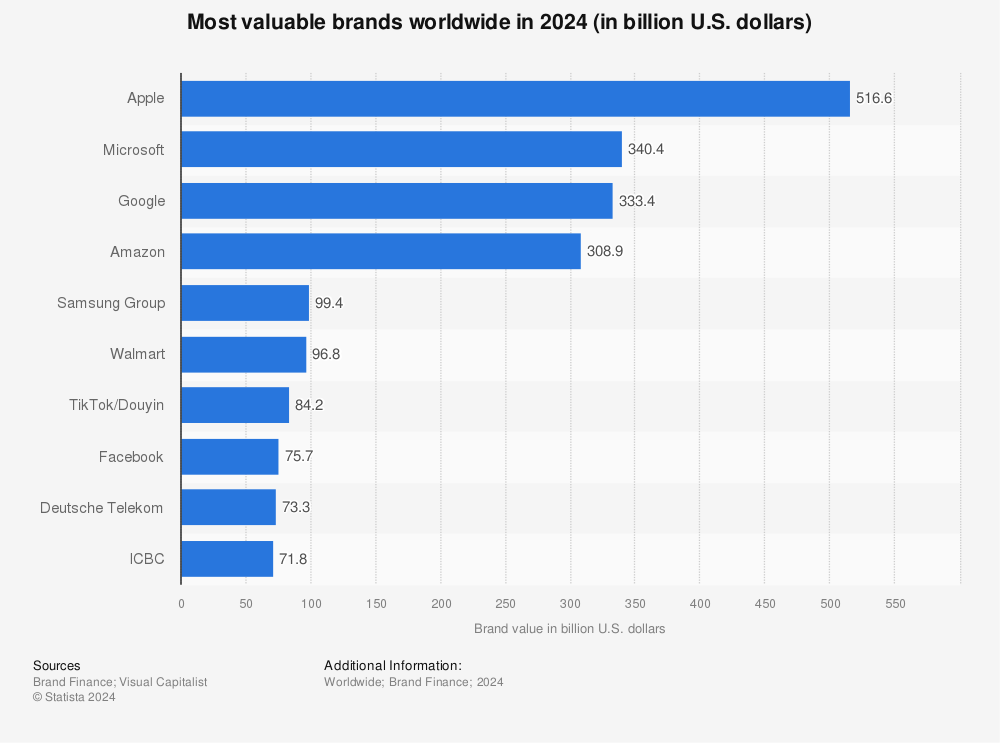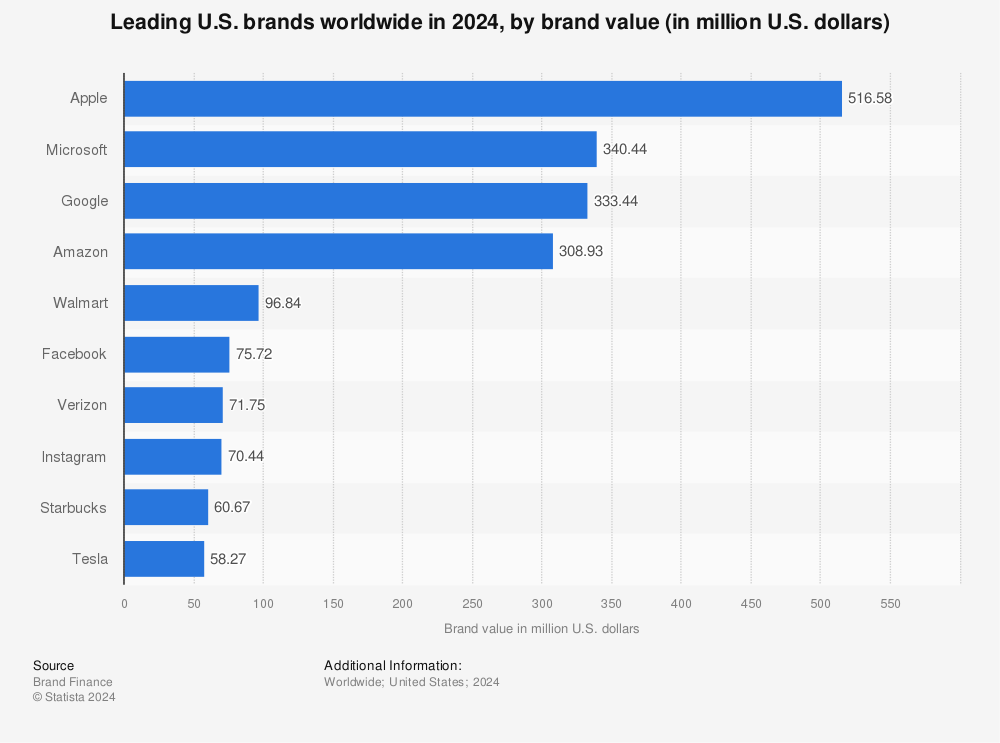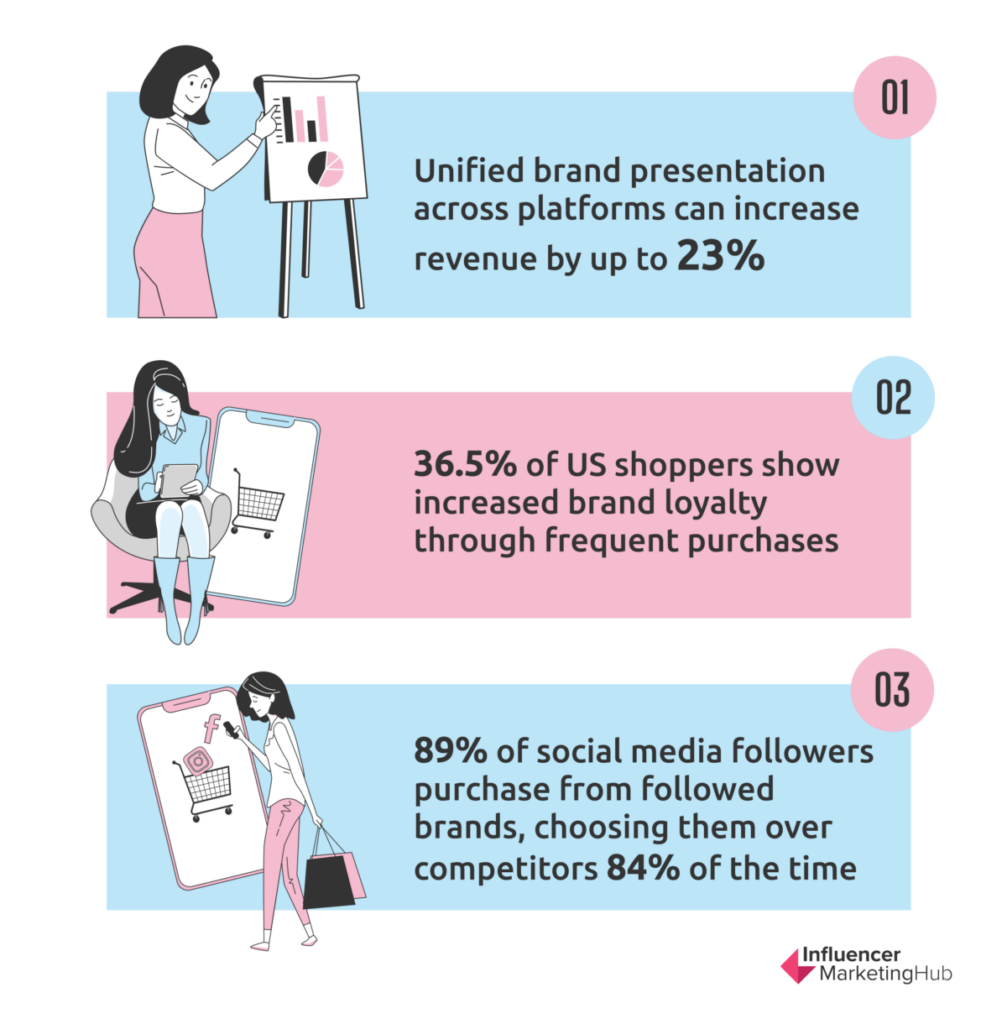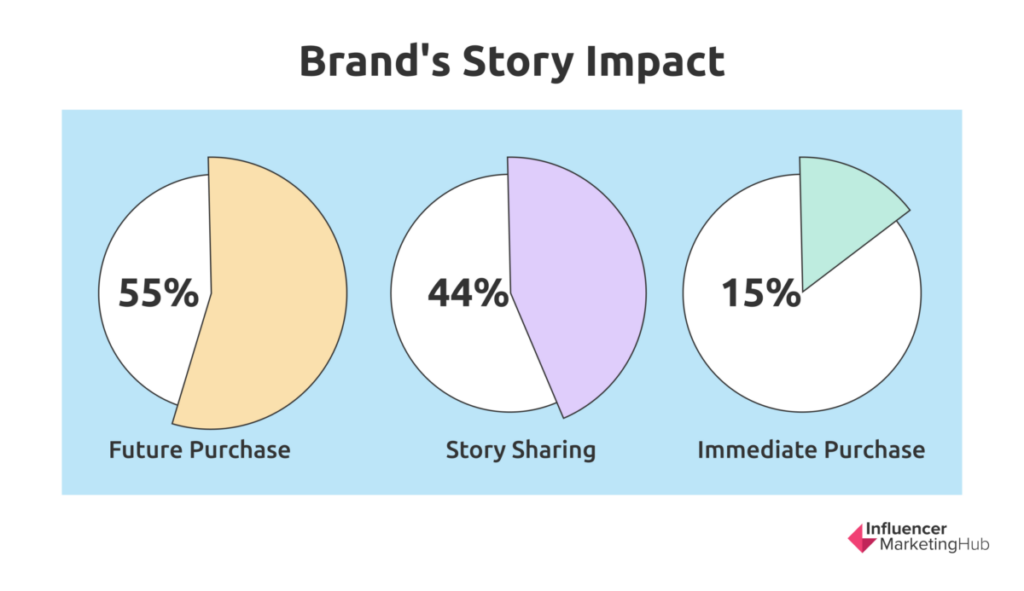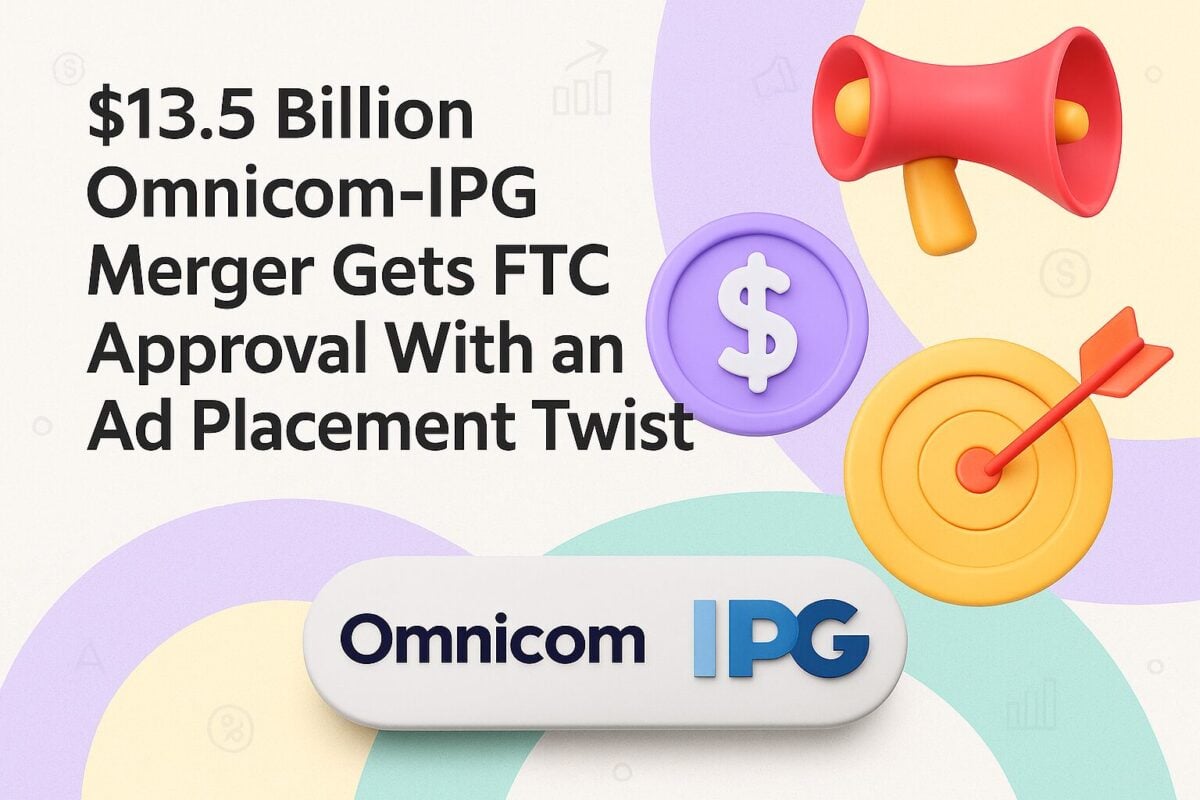The interplay of ideas, messages, and perceptions a company communicates to its audience constitutes its brand - a potent tool that can dramatically impact a business's success. Branding, then, is not just an art; it's a strategic, data-driven endeavor that shapes how the world sees your business and, more importantly, how it responds.
Companies often underestimate the profound impact of brands and trademarks on business-to-business decision-making. Many view branding solely as a means of consumer communication. Yet, some of today's most influential brands, such as Airbnb, LVHG, and Apple, capture the attention and loyalty of businesses as much as they do consumers.
Even companies without any consumer-facing operations, including Nvidia and OpenAI, have meticulously crafted powerful brands, collectively valued at over $1 trillion.
With that, we delve into the captivating world of branding in 2024, driven by groundbreaking statistics.
Our collection of branding statistics and trends for Q3 2024 offers an insightful glimpse into the world of brand perception, consumer behavior, and strategic branding decisions.
Notable Highlights:
- 81% of customers need to trust a brand before buying from them, while 86% of consumers believe that authenticity is important to support a brand.
- Apple is the most valuable brand in the world and the US.
- Over 36% of US shoppers feel loyal to brands they buy frequently from.
- Over 60% of customers are willing to pay more to purchase products from brands they are loyal to.
- Personalization is important in business operations, including branding, as 89% of business leaders believe it will be needed for enterprise success in the next three years.
- More than half the consumers form a first impression about brands visually.
- Of the top 100 brands in the world, 34% use black in their logos.
- Glassdoor reports that 86% of job seekers read reviews about a company before deciding to apply for a job there.
- Companies that have a strong employer brand get 1.5x more applications on LinkedIn.
- According to Nielsen, 63% of marketers say that brand awareness is the most important metric to measure marketing success.
General Branding Statistics
1. Brand Trust and Authenticity Drives Purchasing Behavior
Authenticity and trust form the bedrock of customer loyalty. As per a survey by Edelman, 81% of consumers stated they needed to trust the brand to buy from them. Furthermore, Stackla reports that 86% of consumers believe authenticity is vital when deciding which brands they like and support. Hence, building brand trust and authenticity should be a priority for any brand looking to retain customers and foster loyalty.
2. Apple Is the Most Valuable Global Brand
According to Statista, Apple is the most valuable brand in the world with a worth of $516 billion. It's much ahead of the second most valuable brand, Microsoft, which has a valuation of $340 billion. Microsoft is followed by other notable brands like Google, Amazon, Samsung Group, and Walmart.
It's not surprising that Apple has maintained its position as the most valuable global brand for years now. With a reputation for innovation and exceptional customer experience, Apple has set itself apart from its competitors in the technology industry. Its strong brand identity also plays a major role in its high valuation.
Tim Cook, Apple's CEO, explains,
''We're very simple people at Apple. We focus on making the world's best products and enriching people's lives.''
This simplicity and focus on quality have been ingrained in Apple's brand, attracting loyal customers and maintaining its position as the most valuable global brand.
3. Apple Is Also the Most Value Brand In the US
Since some of the most valuable brands in the world are in the US, Apple's position as the most valuable brand globally also means that it has left all its US competitors behind. Statista reports that Apple is the leading US brand worldwide. Some other brands on the list are Amazon, Walmart, Facebook, Google, and Microsoft.
There's a common trend in the list, and that is most of these brands are technology companies. Apple has surpassed other brands because of its strong brand identity. The company also has a comprehensive suite of products and services, from iPhones to Apple watches, AirPods, and the App Store. iPhone sales account for nearly 46% of Apple's overall revenue. Other services, such as home and accessories and wearables also contribute to the company's net sales.
The Americas are also the largest regional market for Apple, bringing in $37.86 billion of the company's $85.7 billion reported revenue. Moreover, the US also has the most Apple stores. The other two big markets are China and Europe.
4. Tech Is the Largest Industry With Respect to Brand Value
According to Brand Directory, tech is the largest industry when it comes to brand value. The presence of companies like Apple, Microsoft, Google, and Amazon has helped the industry reach this position.
The same report also found that Amazon fell from the first place to the fourth in terms of brand value, while Apple's brand value grew by 74%. With Microsoft and Google becoming more valuable, it's evident that the AI sector is also booming.
However, when talking about brand strength, which is the ability to generate future earnings, the first spot is not held by a tech brand. Instead, WeChat, a Chinese messaging app owned by Tencent, has the strongest brand among all industries.
5. 1 in 3 Consumers Trust the Majority of Brands They Use
Edelman reported that 1 in 3 consumers trust the majority of brands they use. The trend is consistent across the board, as both men and women trust the brands they use equally.
However, there's a slight difference in brand trust based on age. About 33% of consumers aged between 18 and 34 trust the brands they buy or use, compared to 35% of those aged between 35 and 55 or those aged 55 and above. The slight difference may be due to the younger generation having more options for brand selection.
On the other hand, older consumers already have established preferences and are more likely to stick with the brands they trust.
6. Brand Recognition and Consistency Boosts Revenue Generation
Brand recognition is the measure of how readily a brand is recognized by potential consumers, and it's the bread and butter of any successful brand strategy. In a market saturated with competitors vying for attention, brand consistency becomes a key player in building recognition and trust.
According to a Lucidpress study, consistent brand presentation across all platforms can increase revenue by up to 23%. A uniform brand image, message, and voice can bolster recognition, helping your brand stand out in the crowded marketplace.
Brand Loyalty Statistics
7. Brand Loyalty Saves Costs
Customer retention is far more cost-effective than customer acquisition. Thus, brand loyalty becomes a critical focus. As Yotpo's research suggests, 36.5% of US shoppers feel more loyal to brands that they purchase frequently. Consequently, creating meaningful customer experiences and building relationships are vital to fostering this loyalty.
8. 9 Out of 10 Companies Plan to Revamp Their Loyalty Program
Customer loyalty programs are a great way to improve your brand's awareness and sales. Many businesses use customer loyalty software apps to keep track of their loyalty programs. It's evident that these programs work, which is why 90% of companies that already have a loyalty program plan to revamp it in the next few years.
They might switch to a mobile-based system to provide more convenience for their customers. Alternatively, they may incorporate more personalized rewards or gamification elements to make the program more exciting. As we explain later in the article, the majority of business leaders plan to make personalization a core aspect of their customer-centric operations to ensure success in the next three years.
9. Customers Are Willing to Pay More to Shop From Brands They Are Loyal to
If you consider the consumers' willingness to shop from brands they are loyal to, the need for loyalty programs becomes understandable. In Marigold's 2024 State of Loyalty Report, 63% of customers said that they are willing to pay more to buy from a brand they are loyal to.
This may be due to two reasons. First, the customers have already experienced the said brand's products or services, and they trust its quality. Second, customers don't want to risk trying a new brand and being disappointed.
10. Companies Plan to Invest More in Retention Than Acquisition
It's not exactly one of the recent customer loyalty trends, but customer retention is cheaper than acquisition. A report from Antavo found that 2x more companies plan to increase their investments in retention compared to acquisition in 2024.
Why may that be? For one, nearly 3/4th of customers feel loyalty towards a brand or company. That means these customers will try to stick with a brand they already like and trust. On the other hand, attracting new customers involves time and money.
Focusing more on customer retention also reaps excellent rewards for brands since it increases the chances of the customer buying more and becoming a brand advocate. When a customer buys something from a brand the first time, there's a 27% chance of them making a second purchase.
However, once they buy something for the second time, the likelihood of the third purchase increases to 49%. By the third purchase, the chance of them buying a fourth time goes up to 62%.
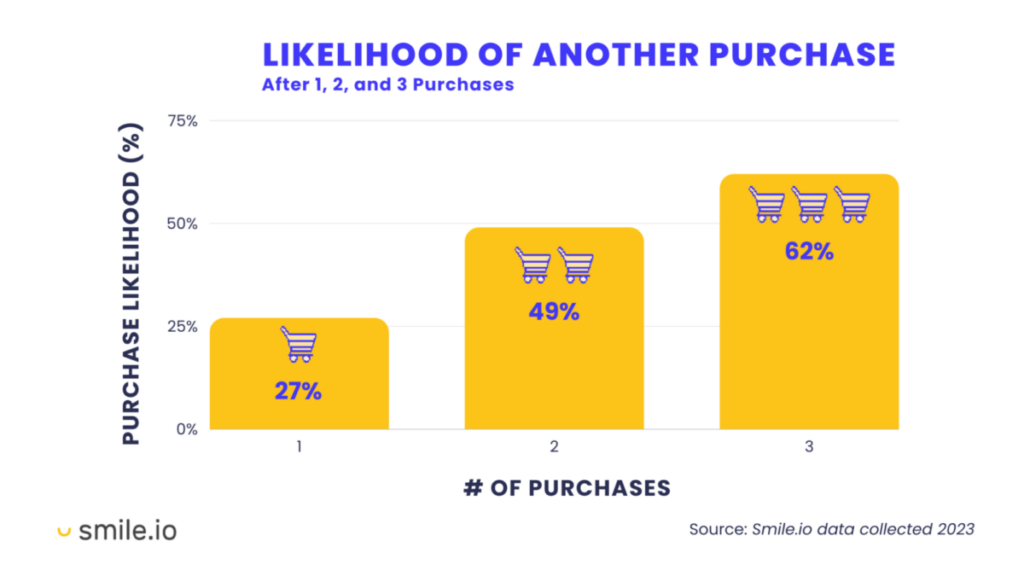
Likelihood of another purchase
11. Business Leaders Believe That Personalization Is Important to Business Success
We live in a time where almost every brand needs a personalization strategy as customers expect tailored experiences. A Segment report found that 89% of business leaders believe personalization to be imperative for their business success in the next three years.
In terms of branding, personalization could mean anything from dynamic landing pages to customized emails. AI personalization can help brands create unique experiences for their customers without spending a ton of monetary or human resources.
12. Customers Who Redeem Personalized Rewards Spend 4.3x More Than Those Who Don’t
It seems like customer loyalty programs work because the Antavo research mentioned above found that customers who use their personalized rewards spend 4.3x more than those who don't use them. This is likely the case because they feel appreciated and valued by the brand, leading to a stronger emotional connection and willingness to spend more.
Or they may simply use their points to make purchases. And they are likely to spend extra if their points don't cover the entire cost of an item because they're already invested in the brand.
Branding Design and Storytelling Statistics
13. Brand Personality and Color Shape Customer Perceptions
Brand personality and color are subtle yet influential tools that can shape customer perceptions. The colors representing your brand can strongly influence how customers perceive your brand's personality. The Pantone Color Institute finds that up to 90% of snap judgments made about products can be based on color alone. This demonstrates the power of color in branding, communicating emotion, and brand values in an instant.
14. More Than Half of First Impressions for Brands Are Visual
The US Chamber of Commerce reveals that 55% of first impressions of brands are visual. So, people form their perception around your brand as soon as they see anything, whether it's your brand's logo, packaging, color palette, or typography.
It's something we can all relate to. For example, when you look at Prada's or Chanel's logo, you immediately think of luxury. The font is elegant and simple, the colors are black and white, and there is an air of sophistication.
On the other hand, American Eagle's logo is fun and casual. The font is playful and bold, while the colors are also bright. So, you instantly know there's a young vibe to the brand.
15. Colors Boost Brand Recognition by 80%
Colors play an important role in brand recognition. According to a paper by Diane Moir, your branding colors can increase brand recognition by 80%.
Again, this is something you can see in your surroundings. The McDonald's yellow and the Coca-Cola red are perfect examples of colors making a brand recognizable.
So, if you want your brand to stand out, choose colors that represent your brand's personality and are memorable. Try to differentiate yourself from other brands. If you use the same color palette as your competitors, you won't be recognizable, or even worse, you'll be mistaken for them.
In a world where muted colors and minimalistic grays are trending, don't be afraid to experiment with bright and bold colors. Most of the top brands in the world use primary colors because of their ability to stand out. In a study, 91% of people were able to recognize Google by simply its colors. Recognition was also high for other brands with bright colors, like Facebook (73%) and McDonald's (84%.).
16. 34% of Global Brands Use Black In Their Logo
There are quite a few of us who reach for anything and everything black when curating our wardrobes because it's a timeless and classic color. It turns out black is also used by more than one-third of global brands in their logos.
Blue is in second place, as 30% of global brands use it in their logo. Other popular colors include red, yellow, green, and orange.
The colors brands choose for their logos also depend on the industry. For example, tech companies mainly reach for blue, while the automotive industry goes for red. Black is a popular choice among luxury brands.
17. Brand Storytelling and Exceptional Brand Slogans Increase Customer Impact
Brand storytelling is a potent tool that enables brands to create emotional connections with consumers. A compelling brand narrative can captivate consumers, making your products and services memorable.
It's no wonder that Headstream found that if people love a brand's story, 55% are more likely to buy the product in the future, 44% will share the story, and 15% will buy the product immediately. Exceptional brand slogans complement storytelling efforts, acting as a catchy and concise summary of your brand's value proposition.
18. Design Elements Make Up Brand Equity
All the elements discussed above contribute to building brand equity, which is the added value brought to your company's products or services that allows you to charge more for your brand than what identical, unbranded products command. High brand equity implies strong customer loyalty, positive brand recognition, and a reputation for quality, all of which contribute to your bottom line.
In a study analyzing the brand equity of Gucci and Adidas following the launch of their fall/winter 2022 collection, both brands experienced significant boosts in brand equity in July. Gucci's brand equity increased by +3.7, while Adidas saw a growth of +3.2, indicating the value associated with each brand at that specific time.
Gucci witnessed the greatest increase in consumer familiarity (+5.5), benefiting from their partnership with Adidas, which introduced Gucci to a wider audience and increased familiarity.
Employer Branding Statistics
19. Most Jobseekers Read Company Reviews Before They Apply For a Job
Branding is not merely for customers but also for potential employees. According to Glassdoor, 86% of job seekers research a company's reputation and reviews before making a decision to apply for a job. In the same report, 65% of job seekers said they read at least 5 reviews before they form an opinion of the company.
If the reviews about your company are positive, it can attract top talent and improve the overall perception of your brand. Negative reviews drive away potential talent. You can build and refine your employer brand by managing and responding to company reviews. It also helps to have a well-designed website and a social media presence.
LinkedIn reports that 52% of candidates first look at a company's website and then their social media profiles to learn more about them. Post positive employee testimonials and snippets of your company culture on your website and social media platforms to show these candidates why they should choose your company.
20. Companies With Strong Branded Get 1.5x More Applications
LinkedIn's internal data shows that companies with strong employer brands get 1.5x more applications than those without them. So, if you want to fill positions quickly, a strong brand can help. Our guide on employer branding best practices can help in this regard.
21. Employer Branding Brings in Top Talent
The same Glassdoor report we've discussed above also found that 75% of job seekers are likely to apply for a job if the employer is active on Glassdoor and shares company culture updates periodically. It seems like job seekers want a glimpse into the company culture, and an employer's branding efforts can provide just that.
Besides sharing company information, another way to build and show your employer brand is through review replies. Employers who respond to reviews show that they value their employees' feedback. That's what most people look for in a workplace.
Branding Marketing Statistics
22. Social Media Marketing Boosts Sales
Social media is a powerful tool for brand exposure and customer engagement. A survey by Sprout Social revealed that 89% of consumers will buy from a brand they follow on social media, and 84% will choose that brand over a competitor.
The unprecedented reach of social media platforms enables brands to interact with customers in real time, providing a platform for brands to showcase their personalities, engage with their audience, and ultimately drive sales.
23. Mobile Optimization, User Experience (UX), and Customer Expectations Are Related
In today's digital world, a mobile-optimized website is not a luxury—it's a necessity. Sweor reports that 57% of internet users say they won’t recommend a business with a poorly designed website on mobile. User experience (UX) on mobile devices impacts your brand image, and a positive mobile UX meets customer expectations, fostering trust in your brand.
24. Brand Awareness Is the Most Important Marketing Metric
Brands use a ton of metrics to measure their marketing successes. However, Nielsens' annual marketing report found that brand awareness tops the list of the most important marketing metrics. While 27% of marketers said that it is extremely important, 36% regarded it as very important.
Driving brand awareness was also among the top marketing objectives reported by business leaders, followed by customer acquisition, customer retention, and customer advocacy. It shows that even during marketing, branding is the primary goal.

Most important marketing metrics
25. Brand Performance Metrics Help Assess Marketing Effectiveness
Performance metrics help brands to assess the effectiveness of their strategies. According to a Nielsen report, brand preference is a key performance metric, with 60% of consumers saying they would buy a brand they prefer over others, even if it's more expensive.
26. Search Engine Ranking Impacts Conversion Rates for Brands
Branding isn't confined to visual aesthetics and storytelling; it extends to digital territories like search engine rankings. Backlinko conducted an analysis of 1,312,881 pages to find that the first result on Google's search engine result pages (SERPs) has a click-through rate (CTR) of 27.6%. It's also 10 times more likely to receive a click than a page on the 10th spot.

CTR of highest Google results
On average, when a page moves one spot up in Google SERPs, its CTR increases by 2.8%, which can mean hundreds, if not thousands, of clicks for a brand. However, the shift is only impactful if it's in the top positions. If your page moves from the 10th to the 9th position, the change isn't too significant.
So, you should create a solid SEO strategy that helps you rank higher on Google's SERPs, as it can help increase your brand's visibility and ultimately impact conversion rates. You can do this in-house or work with professional SEO services.
27. Most Memorable Brands on Social Media Post Regular Content and Engage With Their Audiences
Sprout Social found that of the most memorable brands on social media, 33% post timely and on-trend content, while 38% prioritize creating original content rather than simply following trends. These brands don't just post content and disappear. They also interact with their followers.
The same report revealed that 51% of these brands respond to consumers, and 37% prioritize engaging with their followers over publishing excessive amounts of content. There are two takeaways from these figures.
The first is simple; you have to be active on social media. But that's not enough. There's also a need to engage with your followers, which you can fulfill through community-building tools or designating team members to handle social media pages. Reply to comments and DMs you get from your followers. Also, engage with them through polls and Instagram question stickers.
28. Over 60% of Consumers Have Tagged or Used a Branded Hashtag on Social Media
With some brands having millions of followers on social media, it's evident that consumers follow their favorite brands. But that's not it. They also tag these brands on social media or use branded hashtags. TINT's UGC report found that 60% of customers have used a branded hashtag or tagged a brand on social media.
People may use branded hashtags to enter a giveaway or to submit their content for the client's UGC campaign. Similarly, many customers tag brands in posts featuring their products or services, showing off their purchase or experience.
29. Influencer Marketing Plays a Role in Branding Through UGC
Influencer marketing has become a go-to strategy for many brands looking to extend their reach and impact in the digital sphere. Influencer marketing has become a go-to strategy for many brands looking to extend their reach and impact in the digital sphere.
According to our Influencer Marketing Benchmark Report, user-generated content (UGC) is the main objective for brands running an influencer campaign. Almost 56% of the brands run influencer campaigns to generate UGC, followed by 23% doing it for sales and 21% for brand awareness.
UGC helps in branding by creating authentic and relatable content for a company. It may show the brand's product in use or the merits of their service. Similarly, UGC also increases credibility, which is exactly what brands need to establish themselves in a market flooded with options. Brands can also use UGC to populate their content strategy.
Branding Sustainability and DEI Statistics
30. Sustainability and Branding Go Hand in Hand
As consumer consciousness evolves, sustainability and ethical practices are becoming integral elements of brand strategy. Brands that align themselves with environmental and social issues can cultivate a positive brand image and foster deeper connections with their consumers.
A Nielsen study found that 81% of global respondents feel strongly that companies should help improve the environment, reinforcing the significance of sustainable practices in modern branding.
31. Over 60% of Consumers Want to See Brands Channeling Diversity
There's already been quite a debate about where consumers care about brands taking a stand on social issues. The general consensus is that they do. TINT's aforementioned report found that 65% of customers deem it important to see brands taking a stance on diversity.
Diversity and inclusion initiatives do not only entice customers but also potential employees. Customers come to these brands for their commitment to diversity, while job seekers apply for their inclusive culture. So, it’s a win-win for brands in every aspect.
32. Customers Believe Brands Are As Responsible As Governments to Create Environmental Change
It may come as a surprise to some brands, but customers put them on the same pedestal as government institutions when it comes to social causes. An Economist report revealed that 65% of customers believe brands are just as responsible as the government in terms of driving positive social change. Brands should ensure this responsibility is reflected in their actions and messaging.
33. Customers Want to Buy From Purpose-Driven Brands
The Harvard Business Review reports that 65% of consumers want to buy from purpose-driven brands that take steps toward sustainability. However, the same report says that only 26% of customers actually buy from such brands. This shows both a great opportunity and challenge for businesses to align their messaging with actual actions that benefit social causes.
The disparity between consumer intentions and actions highlights an opportunity for businesses to strengthen their commitment to purpose-driven initiatives. This gap, called the "intention-action gap," suggests that while many consumers express a preference for sustainable and socially responsible brands, other factors may hinder their purchasing decisions.
Price, liking, convenience, and skepticism about the authenticity of a brand's claims are common barriers.
You should go beyond surface-level marketing and embed sustainability and social responsibility into your core operations. That’s the way forward to bridge this gap.
34. Products With ESG-Related Claims Achieve Disproportionate Growth
In the same vein as HBR's report, Mc Kinsey also found that products that make Environment Social Governance (ESG)-related claims averaged 28% cumulative growth in 5 years compared to 20% growth of those that did not. In the categories, the publication examined, products with ESG-related claims accounted for almost half of all retail sales.

Growth of products with ESG claims
These findings show that people want to support brands that align with their values. Since consumers are becoming more conscious of their purchasing decisions, businesses should take note of this trend and incorporate it into their branding efforts.
Conclusion
The branding landscape of 2024 is more dynamic and customer-centric than ever before. Armed with these statistics and insights, branding agencies can develop strategies that resonate with their target audience, build trust, and drive brand loyalty.
Remember, your brand is not just your logo, slogan, or color palette—it's the comprehensive experience you offer your customers and how that makes them feel. As we move forward, it will be exciting to see how these trends evolve and shape the future of branding.
Frequently Asked Questions
What are the main branding trends in 2024?
Some of the main branding trends in 2024 are:
- Purpose-driven branding, where companies align their messaging and actions toward social causes
- Use of AI and automation in branding efforts
- Use of user-generated content on social media and marketing materials
- Personalization in branding strategies
- Use of influencer marketing to reach targeted audiences
- Embracing eco-friendly and sustainable practices in branding efforts
What is the impact of social media on branding?
Social media helps businesses create a brand image for themselves through influencer collaborations and UGC. Brands can also use social media for initial brand awareness. They can use social media platforms to manage their online reputation and engage with their audiences, too.
How can a strong brand influence customer loyalty?
A strong brand cements a positive impression in the minds of customers. Customers are more likely to trust and remain loyal to a brand that they have had positive experiences with, resulting in more sales and higher retention. Strong branding also makes a business memorable and recognizable, which keeps customers coming back.
How does brand consistency affect consumer trust?
Consistent branding ingrains trust in customers' minds because it guarantees them a positive experience with your brand. If a customer has had repeated positive experiences with your brand, they will trust you to maintain that level of quality.
How can small businesses build a strong brand?
Small businesses can build a strong brand by creating a solid online presence and a unique identity. They may also leverage UGC and influencer marketing to establish a loyal customer base. Storytelling can also help. Use it to highlight your brand's values and products. More importantly, offer exceptional customer service to create a positive reputation and trust with your customers.
Which metrics are used to measure brand performance?
Most businesses use brand awareness to measure brand performance. Some other metrics you can use are brand equity, brand sentiment, social media engagement, market share, brand perception, and referral traffic. If you have a loyalty program or subscription-based service, you can also track customer retention and lifetime value.
